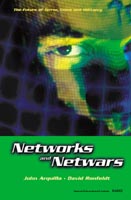
RAND CORPORATION
|
Networks and Netwars: The Future of Terror, Crime, and Militancy John Arquilla, David Ronfeldt (editors) http://www.rand.org/publications/MR/MR1382/
All materials below are free, downloadable PDF files. Contents Preface Chapter One: The Advent of Netwar (Revisited) Part I: Violence-Prone Netwars Chapter Two: The Networking of Terror in the Information Age Chapter Three: Transnational Criminal Networks Chapter Four: Gangs, Hooligans, and Anarchists - The Vanguard of Netwar In the Streets Part II: Social Netwars Chapter Five: Networking Dissent: Cyber Activists Use the Internet to Promote Democracy In Burma Chapter Six: Emergence and Influence of the Zapatista Social Netwar Chapter Seven: Netwar in the Emerald City: WTO Protest Strategy and Tactics Part III: Once and Future Netwars Chapter Nine: the Structure of Social Movements: Environmental Activism and Its Opponents Chapter Ten: What Next for Networks and Netwars? Afterword (September 2001): The Sharpening Fight for the Future Copyright © 2001 RAND The research described in this report was performed under the auspices of RAND's National Security Research Division. All rights reserved. Permission is given to duplicate this on-line document for personal use only, as long as it is unaltered and complete. Copies may not be duplicated for commercial purposes. RAND is a nonprofit institution that helps improve policy and decisionmaking through research and analysis. RAND's publications do not necessarily reflect the opinions or policies of its research sponsors.
|
|
|
